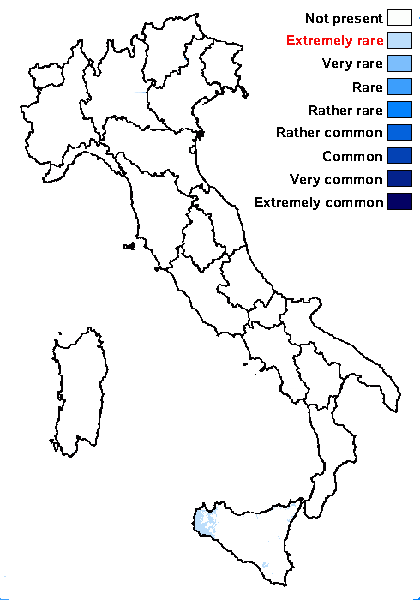Thelenella inductula (Nyl.) H. Mayrhofer
Bibl. Lichenol., 26: 38, 1987. Basionym: Verrucaria inductula Nyl. in Hasse - Bull. Torrey Bot. Club, 24: 448, 1897.
Synonyms: Microglaena inductula (Nyl.) Servít; Microglaena sampaiana B. de Lesd.; Polyblastia inductula (Nyl.) Zahlbr.; Thelenella sampaiana (B. de Lesd.) H. Mayrhofer & Poelt
Distribution: S - Si (Ottonello & Puntillo 1995).
Description: Thallus crustose, episubstratic, rimose-areolate, ochraceous to pale reddish brown, covered with a thick epinecral layer. Perithecia brown, globose to pyriform, largely immersed in the thallus, up to 0.3(-0.5) mm across, with a central, dark brown ostiole. Exciple brown in upper part, colourless in basal part, the upper part with an irregular, colourless epinecral layer; paraphysoids thread-like, c. 1 μm thick, persistent, branched and anastomosing; periphysoids lining the periostiolar cavity, periphyses absent; hymenial gel I-, K/I-. Asci (4-)8-spored, broadly cylindrical to subclavate, fissitunicate, with two functional wall-layers, the inner wall thin and the outer thick, with an ocular chamber, K/I-. Ascospores submuriform to muriform, with 6-8 transverse septa and (1-)2-3 longitudinal septa, hyaline, elongate-ellipsoid, 24-33(-36) x 9-13 μm, the outer wall scarcely thicker than the septa. Pycnidia immersed. Conidia thread-like, hyaline, 13-15 µm long. Photobiont chlorococcoid, the algal cells without a gelatinous sheath. Spot tests: K-, C-, KC-, P-, UV-. Chemistry: without lichen substances.
Note: a mainly Mediterranean lichen found on volcanic rocks, granite and schist, in sheltered and rather shaded, humid situations.
Growth form: Crustose
Substrata: rocks
Photobiont: green algae other than Trentepohlia
Reproductive strategy: mainly sexual
Most common in areas with a humid-warm climate (e.g. most of Tyrrenian Italy)
Commonnes-rarity: (info)
Alpine belt: absent
Subalpine belt: absent
Oromediterranean belt: absent
Montane belt: absent
Submediterranean belt: absent
Padanian area: absent
Humid submediterranean belt: absent
Humid mediterranean belt: extremely rare
Dry mediterranean belt: absent

Predictive model
Growth form: Crustose
Substrata: rocks
Photobiont: green algae other than Trentepohlia
Reproductive strategy: mainly sexual
Most common in areas with a humid-warm climate (e.g. most of Tyrrenian Italy)
Commonnes-rarity: (info)
Alpine belt: absent
Subalpine belt: absent
Oromediterranean belt: absent
Montane belt: absent
Submediterranean belt: absent
Padanian area: absent
Humid submediterranean belt: absent
Humid mediterranean belt: extremely rare
Dry mediterranean belt: absent

Predictive model
 INDEX FUNGORUM
INDEX FUNGORUM
 GBIF
GBIF

